Catholic Customs
 |
 |
 |
 |
 |
 |
 |
Sacred Customs of Holy Thursday - II
The Glorious History of the Mandatum

Our Lord Jesus Christ, after he had supped with His Disciples, washed their feet, and said to them: "Know you what I your Lord and Master have done to you? I have given you an example, that ye also may do the same.” (Antiphon from Maundy Thursday)
Moved by these stirring words of her Spouse, the Church developed a sublime ceremony that imitated as closely as possible Our Lord’s actions at the Last Supper. Since at least the 7th century, a solemn foot washing ceremony known as the Mandatum or "Washing of the Feet" has been performed by the Sovereign Pontiff.
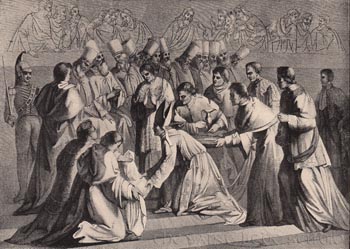
The Pope, surrounded by the Papal Court, washes the feet of 13 poor men of Rome (19th c. engraving)
Thirteen men were chosen in Rome instead of the traditional 12 that occur in because of a miracle of Pope St. Gregory the Great. "This holy Pope used, every day, to wash the feet of 12 poor men, whom he afterwards invited to his own table. One day, a 13th was present: It was an Angel, whom God had sent, that He might thereby testify how dear to Him was the charity of His servant." (2)
After the Pope washed the feet of 13 clerics, the Pope gave each cleric a nosegay and a towel. The Pope than processed across the nave of St. Peter's to a specified room that had a table laid for a meal, He proceeded to wash the hands of the clerics, served them their meal and gave them a blessing. (3)
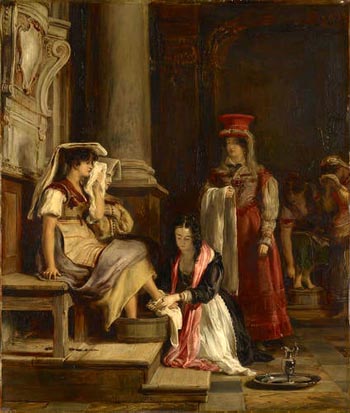
Noble Roman ladies, men & clerics wash the feet of Roman pilgrims
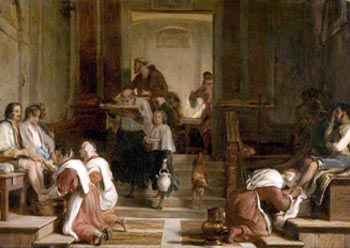
Even into the 20th century in Mexico and parts of Latin America, parish priests would wash the feet of 12 poor men who dressed as the Twelve Apostles. (5)
The splendid example of the clergy brought this charitable act into palaces, manors and cities as monarchs, nobles and laymen of eminence humbled themselves to wash the feet of the lowest members of society. Thus were they taught to see in the poor the person of Christ Himself.
The grandest ceremonies were performed at Rome, Vienna and Munich in the West, and at Moscow, St. Petersburg and Constantinople in the East, although unfortunately the schismatic "Orthodox" officiate at these ceremonies today. After the ceremonies, the poor were given lavish alms and served a multiple course meal.
The poor pilgrims in Rome, considered to be the Pope’s guests, were privileged with a special foot washing ceremony and meal at the Trinit'a de' Pellegrini. The pilgrims who came from a greater distance than 60 miles were escorted to different rooms according to their sex and then served by distinguished members of society of the same sex. (6)
Mary Crawford Fraser gives a beautiful description of this scene in 1851:
"The greatest ladies in the world, in court dress of black velvet and a long black veil and wearing their most magnificent family jewels, came to do honor to the Pope's guests… The Princesses, following Christ's example, went round from one to another on their knees to perform this kindly act… For three nights, from Holy Thursday to Easter Eve, they rendered this tribute to poverty and faith, while their husbands and sons did the same for the men on the other side of the building." (7)
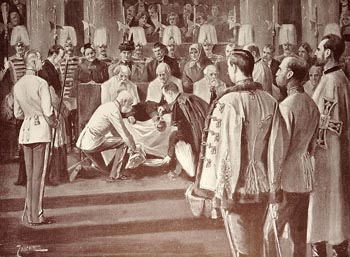
Emperor Franz Joseph washes the feet of poor men
A pictorial account of Emperor Franz Joseph's ceremony follows:
"The Emperor and Empress knelt down, and, moving from one person to the next, washed their feet, dried them, assisted by a Prelate, who held a basin for them, and another cleric, who refilled it with water. Finally each of the 12 aged people received a white leather pouch containing 30 silver coins, together with wine jugs and beakers of green stoneware, before being driven home in a court carriage." (8)
The Spanish Kings held a foot washing ceremony until the 20th century. One moving incident in 1885 described in James Monti's The Week of Salvation occurred when Queen Isabella II’ s diamond bracelet dropped into the basin in which a poor women’s feet were being washed. Monti reports the Queen’s gracious act: “The other woman reached down and took it out of the water to return it to the Queen, but the Monarch handed it back to her, saying: "Keep it, hija mia; it is your luck." (9)
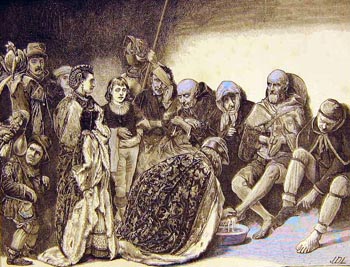
A Monarch in his royal robes kneels &
washes a poor man’s feet
"Maundy" may also be derived from the baskets called "maundy" or "maund" in the old Saxon dialect that were used to distribute food to the poor. British nobles, monarchs, and high-ranking churchmen traditionally washed the feet of 12 or 13 men; however, in later years, the number increased to the amount of years in the life of the personage. (10)
The Catholic Queen Mary I, age 41, performed an elaborate foot washing ceremony in 1556, kneeling on the ground to wash the feet of 41 poor women, after which, she gave to each woman 41 pence, clothing, bread and fish. She even gave her royal gown to the poorest woman.
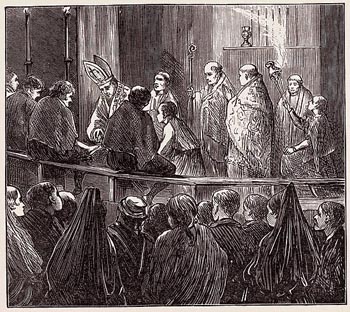
Bishop of Seville washing a poor man’s feet
The infamous Queen Elizabeth I did perform one foot washing ceremony, but only after the feet of the recipients were thrice washed by the laundress, sub-almoner and almoner. She also discontinued Queen Mary’s practice of giving the royal gown to a poor woman and gave a sum of money in a red purse in its stead, thus inaugurating the royal custom held to this day of giving a sum of money to the poor in place of clothing and food.
Thus can be seen how the Protestant Monarchs who laid hold of England separated themselves not only from the True Religion, but also from the Catholic spirit that gave Monarchs true charity.
Would that the elites and prominent members of society once again show their love for the poor and publicly manifest what it means to be a Catholic ruler by re-adopting this sacred ceremony? May Our Lady hasten the coming of her Reign so that the Week in which her Divine Son conquered the empire of darkness may once again bring the greatest rulers to humble themselves on Maundy Thursday as faithful and humble children of Our Holy Mother the Church.
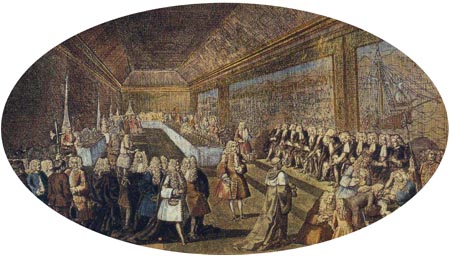
John V of Portugal performs the Washing of the Feet rite
in Ribeira Palace, 1748
- https://unamsanctamcatholicam.com/2023/04/06/liturgical-history-of-the-mandatum/
- Dom Prosper Guéranger, The Liturgical Year, vol. VI (Fitzwilliam, New Hampshire: Loreto Publications, 2013) p. 397.
- William S. Walsh, Curiosities of Popular Customs and of Rites, Ceremonies, Observances and Miscellaneous Antiquities (Philadelphia: J. B. Lippincott Company, 1898), p. 677.
- “It seems that the Mandatum was practiced regularly at the parish level from the late Middle Ages until the 18th century, at which time it begins to die out. The practice continued in various locations into the 19th century, but by then was considered a rarity; in Tasco, Mexico, a record from 1868 notes the Mandatum being performed in a parish on 12 poor men. The men were seated in the church dressed as the Apostles and wreathed in leaves. Their feet were then washed and kissed by the parish priest and vicar, followed by a dozen prominent men of the town who performed the same act. This took place immediately before the sermon. By 1900, the practice at the parish level had apparently died out universally. It was not reintroduced until the 1955 "restoration" of Holy Week by the Sacred Congregation of Rites, which gave us the Mandatum practice as we know it today.” (https://unamsanctamcatholicam.com/2023/04/06/liturgical-history-of-the-mandatum/)
- Erna Fergusson, Fiesta in Mexico (New York: Alfred A. Knopf, 1934), p. 110.
- https://www.thebookofdays.com/months/march/24.htm
- Bonnie Blackburn and Leofranc Holford-Strevens, The Oxford Companion to the Year (New York: Oxford University Press, 1999), p. 618.
- https://www.habsburger.net/en/chapter/humility-foot-washing-ceremony
- https://unamsanctamcatholicam.com/2023/04/06/liturgical-history-of-the-mandatum/
- Dorothy Gladys Spicer, Yearbook of English Festivals (New York: The H. W. Wilson Company, 1954), p. 208.

Posted March 20, 2024
______________________
______________________
 |
 |
 |
 |
 |
 |


